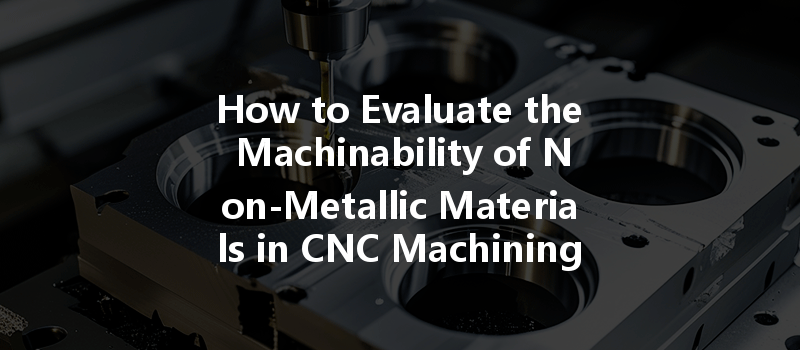Did you know that as much as 60% of the manufacturing sectors are increasingly moving toward non-metallic materials? From carbon fiber composites to advanced polymers, the shift is not merely a trend; it reflects a deeper understanding of material properties and performance characteristics. The versatility of non-metallic materials has opened doors for enhanced designs, reduced weights, and improved functionalities across various industries, including aerospace, automotive, and electronics.
However, evaluating the machinability of these unconventional materials in Computer Numerical Control (CNC) machining poses unique challenges. So, how can manufacturers effectively assess the machinability of non-metallic materials during CNC machining? In this exhaustive guide, we’ll delve into methods, techniques, and considerations vital for evaluating the machinability of non-metallic materials.
The Importance of Machinability Evaluation
Understanding machinability is crucial for several reasons:
With these factors in mind, let’s explore the various approaches and techniques available for evaluating the machinability of non-metallic materials.
Section 1: Understanding Non-Metallic Materials
1.1 Types of Non-Metallic Materials
Before we dive into the evaluation techniques, it’s essential to classify the most commonly used non-metallic materials in CNC machining:
1.2 Properties Impacting Machinability
The machinability of non-metallic materials is influenced by several inherent properties:
Section 2: Machinability Testing Methods
For accurate evaluation, the following methods can be implemented:
2.1 Tool Wear Tests
Tool wear tests involve observing the wear rate of cutting tools as they interact with different non-metallic materials. Conducting these tests can provide insights into the material’s hardness, consistency, and overall behavior when subjected to cutting operations.
2.2 Chip Formation Analysis
Chip formation refers to how material is removed from the workpiece during machining. Analyzing the type of chips produced (continuous, segmented, or powdery) can provide insights into machinability.
2.3 Surface Finish Measurements
Surface finish is a known indicator of a material’s machinability. A higher-quality surface finish typically suggests better machinability.
2.4 Cutting Force Measurement
Recording the cutting force exerted during machining delivers valuable insight into material resistance.

Section 3: CNC Machining Considerations for Non-Metallic Materials
3.1 Tool Selection
Choosing the right tool is indispensable when working with non-metallic materials. Here are some tips:
3.2 CNC Parameters Optimization
Optimizing CNC parameters (feed rate, spindle speed, depth of cut) is crucial for successful machining processes.
3.3 Environmental Aspects
Cooling and lubrication can drastically influence non-metallic material machinability.
Section 4: Evaluating Specific Non-Metallic Materials
Each non-metallic material presents unique challenges. Below are specific strategies for assessing their machinability:
4.1 Evaluating Plastics
4.2 Evaluating Composites
4.3 Evaluating Ceramics
4.4 Evaluating Elastomers
Section 5: Real-World Case Studies
As we continue, let’s examine some successful implementations of machinability evaluations in industrial settings:
5.1 Aerospace Industry
A leading aerospace manufacturer invested in thorough evaluation techniques for machining carbon fiber composites. By organizing regular tool wear tests and chip formation analyses, they were able to develop a reliable machining strategy that reduced overall costs by 15%.
5.2 Automotive Sector
A prominent automotive company moved to implement CNC machining for non-metallic materials in vehicle interiors. By focusing on surface finish measurements, alongside optimized tool selection, they achieved a significant improvement in manufacturing precision.
Evaluating the machinability of non-metallic materials in CNC machining is a multifaceted process that requires diligent assessment and adaptations of tools, parameters, and methods. From understanding material properties to selecting appropriate evaluation methods, every step is crucial for achieving success.
Adopting the strategies discussed will not only help you reduce costs and improve quality but allow for the optimized usage of non-metallic materials in your manufacturing processes. As industries become increasingly reliant on advanced materials, understanding how to evaluate their machinability effectively is an invaluable asset.
Takeaway points include understanding specific material behaviors, selecting the right tools, and measuring key performance parameters—all of which play an essential role in advancing your machining capabilities. Embracing these insights will prepare you for the future of manufacturing and enhance your competitiveness in a rapidly changing landscape.
So, as you navigate the intricacies of machining non-metallic materials, remember that every cut, every chip, and every finished product tells a story of precision, innovation, and opportunity. The realm of non-metallic materials awaits your expertise, and the sky’s the limit. Happy machining!






